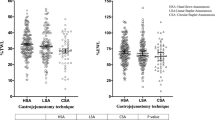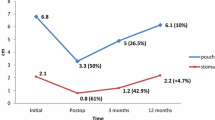Abstract
Background
Roux-en-Y gastric bypass (RYGB) is an effective treatment for severe obesity. However, many patients regain weight over time. The mechanisms for this are unclear, and several factors may contribute, including dilation of the gastrojejunal anastomosis. This study aimed to assess the feasibility of endoscopic gastrojejunal anastomotic tightening and to determine the effect of tightening on body weight.
Methods
Eight patients with significant weight regain and dilated gastrojejunal anastomosis after RYGB were included in this pilot study. Sutures were placed endoscopically at the rim of the anastomosis. When tightened, the sutures formed tissue placations, reducing the size of the anastomotic aperture.
Results
The average preprocedure body mass index (BMI) was 40.5, and the patients had regained a mean of 24 kg from their post-RYGB nadir. The average pouch length was 5.7 cm, and the average anastomotic diameter was 25 mm. The average postreduction diameter was 10.0 mm (68% reduction). Six of the eight patients showed weight loss (mean, 10 kg) at 4 months. Repeat procedures were performed for three patients who had lost 4, 5, and 9 kg, respectively with the initial procedure. After the second anastomotic reduction, the final diameters were, respectively, 14, 5, and 5 mm. The first patient did not have further weight loss. The remaining two patients showed a total weight loss of 19 and 20 kg, respectively, at 5 months. All 11 reductions were accomplished without significant complication. The average postreduction BMI was 37.7, and the percentage of excess weight loss was 23.4%.
Conclusion
Peroral endoscopic suturing to tighten dilated gastrojejunal anastomoses appears technically feasible and safe. This procedure is associated with variable but significant weight loss, and preliminary results suggest that it may offer a new treatment option for postbypass weight regain in selected patients.





Similar content being viewed by others
References
Capella JF, Capella RF (1996) The weight reduction operation of choice: vertical banded gastroplasty or gastric bypass. Am J Surg 171: 74–79
de Csepel J, Nahouraii R, Gagner M (2001) Laparoscopic gastric bypass as a reoperative bariatric surgery for failed open restrictive procedures. Surg Endosc 15: 393–397
Felsher J, Farres H, Chand B, Farver C, Ponsky J (2003) Mucosal apposition in endoscopic suturing. Gastrointest Endosc 58: 867–870
Filipi CJ, Lehman GA, Rothstein RI, Raijman I, Stiegmann GV, Waring JP, Hunter JG, Gostout CJ, Edmundowicz SA, Dunne DP, Watson PA, Cornet DA (2001) Transoral, flexible endoscopic suturing for treatment of GERD: a multicenter trial. Gastrointest Endosc 53: 416–422
Fobi M, Lee H, Holness R, Cabinda D (1998) Gastric bypass operation for obesity. World J Surg 22: 925–935
Higa KD, Ho T, Boone KB (2001) Laparoscopic Roux-en-Y gastric bypass: technique and 3-year follow up. J Laparoendosc Adv Surg Tech 11: 377–382
Kadirkamanathan SS, Evans DF, Gong F, Yazaki E, Scott M, Swain CP (1996) Antireflux operations at flexible endoscopy using endoluminal stitching techniques: an experimental study. Gastrointest Endosc 44: 133–143
Linner JH, Drew RL (1992) Reoperative surgery: indications, efficacy, and long term-follow-up. Am J Clin Nutr 55: 606S–610S
Macgregor AM (1992) Revision of staple line failure following Roux-en-Y gastric bypass for obesity: a follow-up of weight loss. Obes Surg 1: 151–154
Mahmood Z, McMahon BP, Arfin Q, Byrne PJ, Reynolds JV, Murphy EM, Weir DG (2003) Endocinch therapy for gastro-oesophageal reflux disease: a one-year prospective follow-up. Gut 52: 34–39
McCormick JT, Papsavas PK, Caushaj PF, Gagne DJ (2003) Laparoscopic revision of failed open bariatric procedures. Surg Endosc 17: 413–415
Powers PS, Rosemurgy A, Boyd F, Perez A (1997) Outcome of gastric restriction procedures: weight, psychiatric diagnoses, and satisfaction. Obes Surg 7: 471–477
Santry HP, Gillen DL, Lauderdale DS (2005) Trends in bariatric surgical procedures. JAMA 294: 1909–1917
Schwartz RW, Stodel WE, Simpson WS, Griffen WO (1988) Gastric bypass revision: lessons learned from 920 cases. Surgery 104: 806–812
Schweitzer M (2004) Endoscopic intraluminal suture plication of the gastric pouch and stoma in postoperative Roux-en-Y gastric bypass patients. J Laparoendoscopy Adv Surg Tech A 14: 223–226
Spaulding L (2003) Treatment of dilated gastrojejunostomy with sclerotherapy. Obes Surg 13: 254–257
Sugerman HJ, Kellum JM Jr, DeMaria EJ, Reines HD (1996) Conversion of failed or complicated vertical banded gastroplasty to gastric bypass in morbid obesity. Am J Surg 171: 263–269
Sugerman HJ, Starkey JV, Birkenhauer R (1987). A randomized prospective trial of gastric bypass versus vertical banded gastroplasty for morbid obesity and their effects on sweets versus non–sweets eaters. Ann Surg 205: 613–624
Thompson C, Carr-Locke D, Saltzman J, Lautz D, Robinson M (2004) Peroral Endoscopic repair of staple-line dehiscence in Roux-en-Y Gastric Bypass: a less invasive approach. DDW-SSAT (poster presentation)
Whittgrove AC, Clark GW (2000) Laparoscopic gastric bypass, Roux-en-Y 500 patients technique and results, with 3–60 month follow-up. Obes Surg 10: 376–377
Author information
Authors and Affiliations
Corresponding author
Rights and permissions
About this article
Cite this article
Thompson, C.C., Slattery, J., Bundga, M.E. et al. Peroral endoscopic reduction of dilated gastrojejunal anastomosis after Roux-en-Y gastric bypass: a possible new option for patients with weight regain. Surg Endosc 20, 1744–1748 (2006). https://doi.org/10.1007/s00464-006-0045-0
Received:
Accepted:
Published:
Issue Date:
DOI: https://doi.org/10.1007/s00464-006-0045-0




